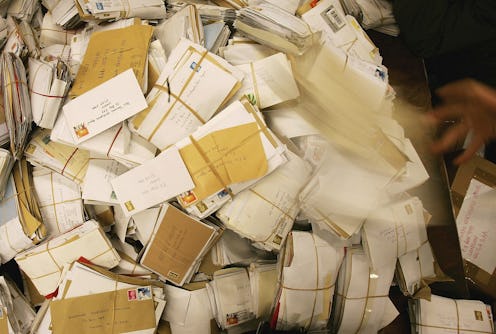
Each day of self-isolation that goes by, the more pandemic-related questions we have. Should social distancing be renamed physical distancing? Should we all be wearing face masks, regardless of whether we have symptoms or not? Is it morally OK to buy things online right now? But, ethics of deliveries aside, there is also the very practical question of whether coronavirus can live on your mail. We look into whether you can pick up COVID-19 from your post, and how to ensure you stay safe.
Can Coronavirus Live On Mail?
Coronavirus spreads from person to person via respiratory droplets; coughing, sneezing, etc. Though recent studies found that coronavirus can be detected for up to 24 hours on cardboard, and up to two to three days on plastic and stainless steel, it is currently unclear how long it can survive on paper. But official government sources in the U.S. estimate that the risk of getting infected from a package is low, even if an infected person has touched it.
Parcelforce Worldwide and Public Health England (PHE) advise that people receiving parcels are not at risk of contracting coronavirus. "From experience with other coronaviruses, we know that these types of viruses don’t survive long on objects, such as letters or parcels," per Yahoo! News.
Do I Need To Disinfect My Post?
Dr. Perpetua Emeagi, a lecturer in human biology and biological sciences at Liverpool Hope University and specialist in public health and vaccine development, advises Metro to follow an "open it, read it, and bin it strategy" to stop the spread of the virus.
"Do not leave [mail] lying around," she says, "and take extra care not to allow it to come into contact with other surfaces." She suggests opening post, disposing of envelopes, and immediately washing your hands for the recommended 20 seconds.
Disinfecting mail is an age-old practice, per The New York Times, and dates back to 1377 and the bubonic plague: "Items that were considered particularly susceptible, including textiles and letters, were also subject to fumigation: dipped in or sprinkled with vinegar, then often exposed to smoke from aromatic substances, from rosemary to, in later years, chlorine." Disinfection techniques remained largely the same for centuries, but after anthrax attacks in 2001, the U.S. Postal Service started beaming post addressed to specific postcodes with high-energy ionising radiation to kill bacteria and viruses. As yet, no such practices have been adopted during the coronavirus pandemic.
Is It Safe To Send Cards Home?
In short: yes. Over Mother's Day weekend, Royal Mail confirmed it was perfectly safe to send cards to your mum. It could also help those feeling lonely or struggling with isolation when they need it the most.
What Is Royal Mail Doing About Coronavirus?
Royal Mail and Parcelforce Worldwide are still running delivery and collection services, but have made some adjustments to parcel handling procedures and services to ensure the safety of their staff and the public.
By and large, customers will no longer be required to sign for packages, instead logging the first and last name of the person accepting an item and recording the geolocation of a delivery. In line with social distancing measures, parcels are now being left by doors, with the postman or delivery driver waiting at a safe distance to ensure they are collected where necessary.
If you are unable to come to the door, a ‘Something for You’ card will be left behind, advising customers to stay at home (in line with government advice) and instructions on how to book a free redelivery of their item.
You can consult the Royal Mail website and the Parcelforce Worldwide website for detailed information on these and further changes.
Read more here:
Is It Safe To Online Shop With Coronavirus?
How To Watch The Queen’s Speech On Coronavirus
If you or someone you’ve been in close contact with appears to have shown or be showing symptoms of coronavirus, which include fever, shortness of breath, and coughing, visit the NHS website in the UK to find out the next steps you should take, or visit the CDC website in the U.S. for up-to-date information and resources. You can find all Bustle’s coverage of coronavirus here, and UK-specific updates on coronavirus here.